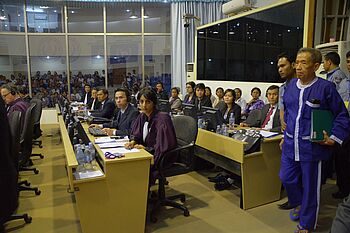Visitors study documents inside the exhibition of the Choeung Ek Memorial. The Cambodian “auto-genocide,” which is how it is often referred to by researchers of the Khmer Rouge mass murder, caused international outrage. But in Germany and other countries, there were also radical leftwing proponents of Pol Pot’s agrarian communism. Over the last 20 years, scholarly research has focused more strongly on Cambodia’s history.
Credit: Hubertus Knabe
Hoping for Justice

Credit: Extraordinary Chambers in the Courts of Cambodia / Public domain
Kaing Guek Eav, the former head of the S-21 prison, stands in a prison uniform before the special court in Cambodia. Prosecutors, judges and defense attorneys from all over the world attended, listening to translations via headphones. It took a long time to establish the Extraordinary Chambers in the Courts of Cambodia, as the Khmer Rouge Tribunal was officially called. When it finally commenced its work in 2006, many analysts saw it as a reason for hope. In light of its modest achievements, it is now viewed more skeptically.
In 2009, the lawyers Philippe Gréciano and Birte Kaspers examined the beginning of the criminal investigation of the Pol Pot regime. In the first part of their essay “Transitional Justice or Reconciliation in Cambodia?” they describe the rise and fall of the Khmer Rouge and the role that Cambodia played throughout the world. They focus, in particular, on the world’s reaction and the role that the United Nations played in the peace process in 1991.
They also analyze the establishment and operations of the Special Court, which was designed as a so-called hybrid court: In it, Cambodian judges have a majority, but all decisions require the support of at least one foreign judge. In their study, the authors warn against expecting too much from the tribunal: “One reason why it will not be easy to achieve transitional justice in this situation – something underestimated by many non-lawyers – is the large amount of evidence it takes to attribute individual crimes committed some thirty years ago to specific individuals – without detailed documentation. The trial observers will painfully recognize how laborious and fragmented, as well as lengthy and disturbing, the search for the truth can be.”
Click here for the full text of the study (in German).
Links
Website of the Red Khmer Tribunal
Legal scholar Jörg Menzel on the Red Khmer Tribunal (registration required)
Legal scholar Randle C. DeFalco on the Cases 003 and 004 at the Khmer Rouge Tribunal
After the Dictatorship. Instruments of Transitional Justice in Former Authoritarian Systems – An International Comparison
A project at the Department of Modern History at the University of Würzburg
Twitter: @afterdictatorship
Instagram: After the dictatorship
With financial support from the German Federal Ministry for Economic Cooperation and Development
Buddhist Peacebuilding in Cambodia

Monks dressed in orange are a natural part of street life in Cambodia. But they were killed in large numbers under the Khmer Rouge, which believed that to build a new society, religious ties – along with all cultural traditions – had to be destroyed. In spite of this, after communism came to an end, the patriarch of Cambodian Buddhism spoke out against punishing the perpetrators. An essay describes Maha Ghosananda’s unusual approach to dealing with the past.
In an anthology on “post-secular world politics,” Hannah Landwehr, a speaker for the association Forum Civil Peace Service, addresses how Ghosananda contributed to overcoming the bloody conflict. According to the author, although the Khmer Rouge attempted to eradicate it, religion still forms the backbone of Cambodian society. The Buddhist temple continues to be the center of Cambodian life. The Cambodian monastic community, which acts as a politically neutral mediator between the king, the state and the population, also enjoys strong trust as a moral authority.
Against this background, the Buddhist leader, who died in 2007, played an important role in the difficult process of reconciliation. His participation in the peace negotiations in the late 1980s – as a spiritual companion, not as a negotiator – carried great symbolic importance. He and other monks integrated the negotiations into a Buddhist setting with meditation and prayer. Beginning in 1992, Ghosananda organized annual pilgrimages, called the Dhammayietra, or peace marches, that were based on a 2,500-year-old Buddhist tradition. Monks marched across the country, blessing the villagers with holy water as a sign of spiritual purification, and dipping burning incense branches into holy water as a gesture to symbolize the extinguishing of flames of war.
Whereas Christian-influenced Western societies place emphasis on punishing the perpetrator, Buddhism pursues a path of reconciliation. Ghosananda has even blessed the fighters and leaders of the Khmer Rouge. Rather than having them face trial, he encouraged them to shave their heads and become monks – as a middle course between mercy and condemnation.
In the author’s view, what sounds strange to Western ears makes perfect sense to Cambodians. In a society previously unfamiliar with the ideas of a liberal democratic state, creating peaceful social structures based on constitutional reforms and elections alone will not be successful. Western conflict resolution models have to be accompanied by local strategies for solving conflict, which often contain an unimagined potential for peace. For a society deeply divided by the war, Buddhism in Cambodia represents the only identity-building factor for all parties involved in the conflict.
Click here for the anthology containing the article by Hannah Landwehr (in German).